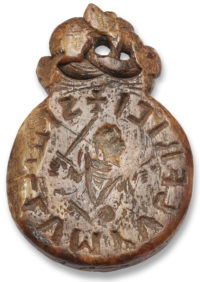 The British Museum has acquired a rare Anglo-Saxon seal matrix predating the Norman Conquest. It was discovered in a box in a garden shed in Sittingbourne, Kent, in 1976, and the British Museum has been trying to add it to its collection ever since. Now, thanks to funding from John H Rassweiler, the Ruddock Foundation for the Arts, the Henry Moore Foundation and British Museum Patrons, it has finally succeeded.
The British Museum has acquired a rare Anglo-Saxon seal matrix predating the Norman Conquest. It was discovered in a box in a garden shed in Sittingbourne, Kent, in 1976, and the British Museum has been trying to add it to its collection ever since. Now, thanks to funding from John H Rassweiler, the Ruddock Foundation for the Arts, the Henry Moore Foundation and British Museum Patrons, it has finally succeeded.
Shortly after its discovery, the circular piece 4 cm in diameter was identified by archaeologists as an exceedingly rare early 11th century seal Anglo-Saxon seal matrix, one of only five surviving seal matrices predating the Norman Conquest and one of only three made of walrus ivory. Comparison with other seals from the period pointed to a date of around 1040-1050.
It is carved out of walrus ivory and is inscribed “SIGILLUM WULFRICI +” (meaning “seal of Wulfric”) in Anglo-Saxon all caps. In the middle is the 3/4 length figure of a bearded man holding an upraised sword in his right hand. He faces left and points with his left hand. A flange above the matrix is in the form of a bird-headed dragon or serpent entwined with itself, biting its tail. It is perforated, indicating it was a suspension lug so the seal could be worn as a pendant.
The sword indicates that Wulfric was a secular figure rather than a cleric. He had to have been of high rank in order to have a seal, and based on comparisons to the closest of the other surviving Anglo-Saxon seals (the Godwin seal, also in the British Museum), he could have been a theyn or minister to the King of England.
It was sold at Christie’s auction in March of 1977 where the British Museum was outbid by the British Rail Pension Fund. The BRPF loaned the seal to the British Museum for almost two decades before deciding to sell the piece at auction in 1996. The museum tried a second time to acquire it, but again was outbid, this time by Norwegian shipping heir and avid manuscript collector Martin Schøyen. When the Schøyen Collection put its entire collection of medieval seal matrices up for auction this summer, the British Museum took no chances. They ensured that the third time would be the charm and arranged a private sale of the Seal of Wulfric beforehand.
Lloyd de Beer, the Ferguson curator of Medieval Britain and Europe at the British Museum said: “We’re delighted to have this incredible object join our collection. These things are extremely rare and it is an object that brings us close to a pivotal moment in history. Within a generation England would be completely transformed, and this object introduces us to one of its people.”
Wulfric Spot (died circa 1004) was an Anglo-Saxon nobleman. His will is an important document from the reign of King Æthelred the Unready. Wulfric was a patron of the Burton Abbey in Burton on Trent. Wulfric’s brother was Ælfhelm, Ealdorman of York or Northumbria from 993 until he was killed in 1006.
Although some late sources places Wulfric’s death as late as 1010, and John of Worcester’s chronicle has been read as suggesting that he died at the battle of Ringmere in that year, he probably died between 1002, when his will was begun, and 1004, when King Æthelred issued his charter approving it. He was buried in the cloister of Burton alongside his wife. In later times Burton Abbey marked the occasion of his death on 22 October.
———-
Ðá com Sparhafoc tó him mid ðæs cynges gewrite and insegle. Geþenc nú gyf ðínes hláfordes ǽrendgewrit and his insegel tó ðé cymþ hwæðer ðú mǽge cweþan ðæt ðú hys willan ðǽr on gecnáwan ne mǽge
———-
PS: In Sittingbourne, Kent our school on the Continent had a partner all-girls school that we all visited on an annually student exchange, and they in return visited us. I very well remember my English teacher and his rather cheesy anouncement with his sleepy voice on the public intercom: “All the English girls, please come to the Filmsaal, …I repeat, …all the English girls, please come to the Filmsaal”.
I question the handedness described in the text.
The image when cast by the seal would show the sword being held in the left hand, right?
… off to dig through my shed. Hopefully I have some treasures inside. Anyone for a 20 year old lawnmower?